- Parisa Adhami
- information
- 433 views
- 0 comments
Art is a display of people's culture, identity, and history. Regarding Canadian art, you will find particular information about their diverse cultures and vast geography. Canadian art is a field that includes some distinctive parts or sides that are influenced by indigenous culture and European traditions. The people who settled early in this region impacted Canadian art. This article will explore the historical movements and significant factors shaping Canadian art. You can also find how Canadian art influences the nation's identity.
Table Of Content
- Early Indigenous Art: A Cultural Foundation
- European Influence and Colonial Art
- Canadian Inuit Art
- The Group of Seven and the Birth of Canadian Landscape Painting
- Post-War Canadian Art and the Rise of Abstraction
- Indigenous Art in the Contemporary Era
- Diversity in Contemporary Canadian Art
- Canadian Art on the Global Stage
- Last words on Canadian Art
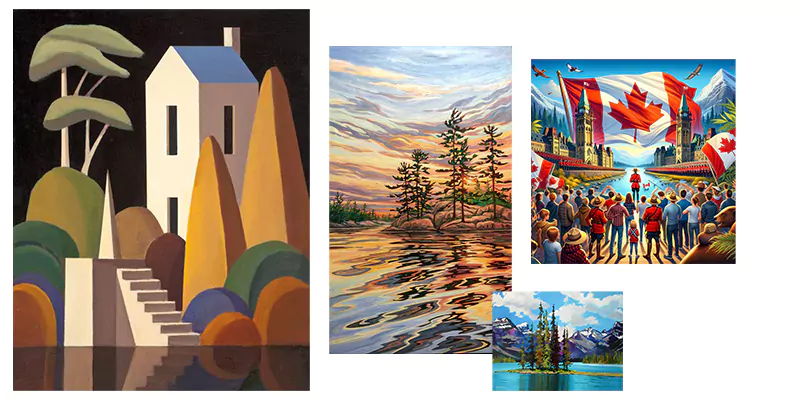
Early Indigenous Art: A Cultural Foundation
We can find the root of Canadian art's history long before the early settlers of Europe came to this region and resided many years ago, creating art deeply connected to their Canadian cultural traditions, spirituality, and environment. The art attributed to Indigenous Canadians was formed in various ways in various media, consisting of carvings, paintings, textiles, and beadwork. One of the most notable artworks attributed to early Indigenous people is the West Coast totem poles, such as the Haida, Gitxsan, and Tsimshian. The totem poles are helpful as artistic objects to decorate and also for ceremonial purposes. Animals and nature commonly inspire these works of art. On the other hand, Canadian works of art are supposed to depict special vital events.
Similarly, Inuit art in the Arctic region is known for its stone carvings and sculptures, often depicting animals such as seals, bears, and whales, which are integral to the Inuit way of life. The significance of Indigenous art extends beyond its aesthetic value. It is a visual language that conveys stories, traditions, and worldviews. Despite the disruptions caused by colonization, Indigenous artists have maintained their cultural practices and continue to innovate, blending traditional techniques with contemporary styles to address historical and present-day issues.
Here is more detailed information about "Canadian Indigenous Cultures and History" and everything you want to know about it.
European Influence and Colonial Art
A fresh period in Canadian art started with the entrance of European settlers in the 16th century. The main strives of early colonial art were religious and factual. European creative traditions were introduced by missionaries and settlers, who were mainly interested in religious iconography, landscape painting, and photography to document the "new world" for European audiences. François de Laval, a Jesuit priest, was among Canada's first known European artists. He created religious paintings and drawings intending to convert Indigenous peoples to Christianity. European settlers' art in the 18th and 19th centuries mainly focused on landscape and portraiture, frequently romanticizing Canada's colossal wilderness. Artists such as Paul Kane, who traversed the nation extensively in the mid-1800s, created intricate portraits of Indigenous.
Cyrus Crafts; Luxury & Unique Products
Canadian Inuit Art
"Canadian Inuit art" describes a unique artistic expression produced by the Inuit, an Indigenous people living in Canada's Arctic area. Their work depicts the interaction between the Inuit and their harsh surroundings, as well as their religion and folklore.
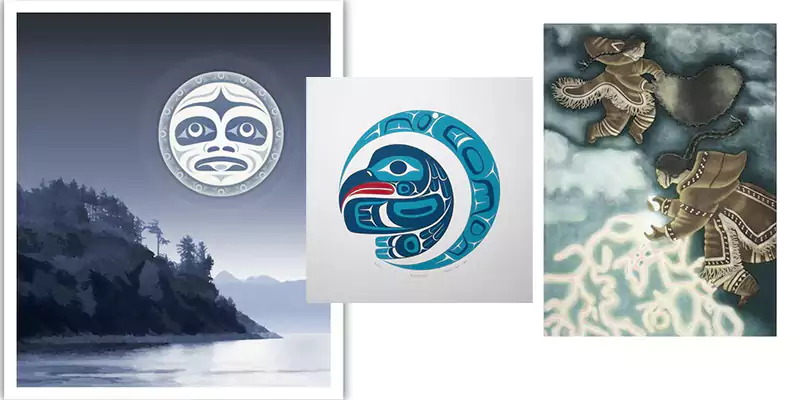
Sculpture and Carvings:
It is strongly influenced by Inuit culture, tradition, and nature. Inuit art is well known for its intricate carvings, which are frequently created from materials like soapstone, bone, ivory, or antler. These sculptures usually feature human characters, legendary creatures, and animals (seals, bears, and birds).
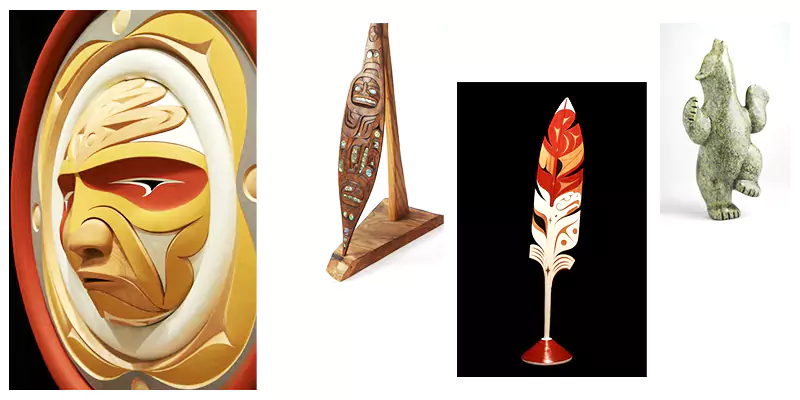
Printmaking:
Inuit tribes began using printmaking techniques in the middle of the 20th century, producing limited-edition prints. These prints frequently feature stylized representations of nature, everyday life, and Inuit mythology.
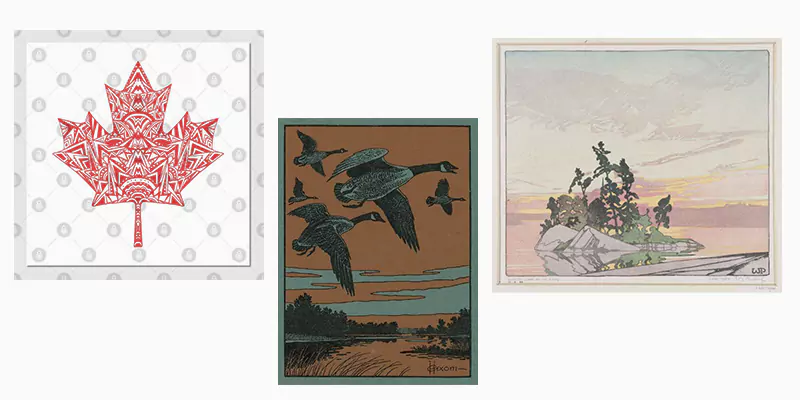
Textiles and Sewing:
Inuit women are renowned for their magnificent textile work, including their traditional attire, wall hangings made of felt and other fibers and parkas made of animal skins. Early in the 1500s, Canada's fur trade took place, and fur was prized in Europe for use in felt hat production. The patterns often portray animals and Inuit legends, and they frequently use stunning colors and patterns.
Jewelry and Tools:
Inuit artists craft functional art, such as jewelry and hunting tools, often intricately decorated.
Themes in Inuit Art:
- Animals: Reflecting their environment and reliance on hunting, animals like caribou, seals, whales, and polar bears are common subjects.
- Spirituality and Shamanism: Inuit art often depicts spirits, shamans, and supernatural beings, representing the Inuit belief in the spiritual connection between humans, animals, and nature.
- Daily Life and Survival: Traditional Inuit activities, like hunting and fishing, are frequently portrayed.
The Group of Seven and the Birth of Canadian Landscape Painting
At the beginning of the 20th century, the most symbolic movement of Canada's art appeared. The artist, trained in 1920, attempted to create a clear Canadian art emphasizing European traditions. Violent beauty of Canadian landscape. The Group of Seven, which included artists such as Lawren Harris, A. Y. Jackson, and Tom Thomson (who was closely associated with the group but died before it was officially formed), focused on capturing the vast wilderness of northern Ontario and other remote areas of Canada. Their work is characterized by vivid colors, dynamic compositions, and a sense of spirituality that imbues the natural landscape with symbolic meaning. For example, Lauren Harris uses simplified and dazzling colors to draw a simple scene with mysterious and abstract qualities from the Canadian Arctic and rocky mountains. I conveyed the sublime beauty of these distant areas. The Seven Visions' Canadian landscape vision, as the source of national identity, has helped Canadians to form a way to see the relationship between themselves and the natural environment.
The seven groups are attracting attention in determining Canadian art. Still, they have been criticized for their narrow precautions in the desert and the experience and prospects of the indigenous people and the urban population. Nevertheless, the group's heritage is the cornerstone of Canadian art history, and the impact can be seen in the works of Canadian artists.
Post-War Canadian Art and the Rise of Abstraction
In the years following World War I and II, Canadian art became more diverse in subject matter and style. The influence of European modernism, especially abstraction, began to make its mark on Canadian artists. Painters such as Jean-Paul Riopelle and Paul-Émile Borduas were at the forefront of this movement in Quebec, where a group known as Les Automatists embraced Abstract Expressionism as a form of artistic and political rebellion. Their manifesto, "Refus Global," rejected traditional values in art and society, asserted freedom of expression, and broke with established norms.
Riopelle incarnated the vitality and dynamism of Canadian art after World War II with her expansive, thriving abstract canvases, which she frequently painted with a putty knife. His commitments, in addition to Borduas's and other Automatistes', aided in situating Canadian art in the larger context of global modernism. In other regions of the nation, abstract art was also gaining popularity. Color field painting and geometric abstraction were research projects conducted by Toronto artists Jack Bush and Harold Town. Significant cultural enterprises like the Canada Council for the Arts and the National Gallery of Canada were established throughout this period. These evidenced Canadian artists and reared the description of Canadian art nationally and internationally.
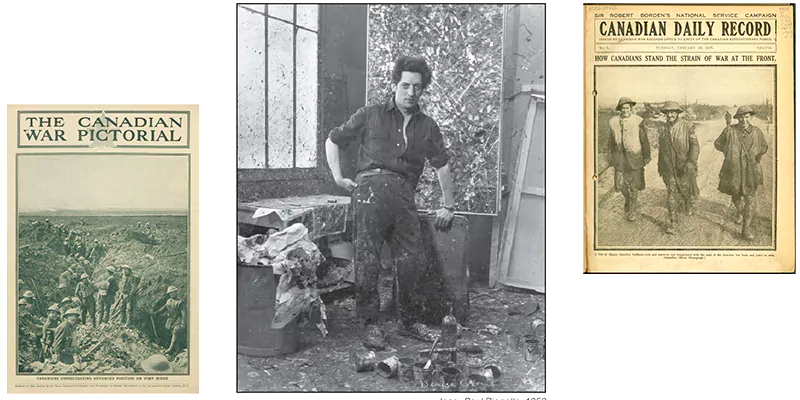
Indigenous Art in the Contemporary Era
A notable revival of Indigenous Canadian art happened at the end of the 20th and the start of the 21st centuries. Indigenous artists faced the colonial era through their artistic works and played an important role in recreating their cultural heritage. The "Picasso of is one of the North," Anishinaabe artist Norval Morrisseau, is the movement's most prominent name. Inspired by Anishinaabe mysticism and spirituality, Morrisseau generated vibrant, symbolic paintings that have significantly impacted Indigenous and non-Indigenous art in Canada.
Indigenous modern artists pushing boundaries through their art to address loss of identity, recognition, and unification include Christi Belcourt, Rebecca Belmore, and Kent Monkman. For instance, Canadian artist Kent Monkman is famed for his thought-provoking paintings and installations that have advanced European portraits of Indigenous peoples while denouncing the colonization legacy of residential schools.
The prominence of Indigenous art in contemporary Canadian culture reflects a broader movement toward reconciliation and the recognition of Indigenous rights. Exhibitions such as the 2017 "Sakahàn" at the National Gallery of Canada, which showcased contemporary Indigenous art from around the world, have helped to elevate Indigenous voices and challenge the dominant narratives of Canadian history.
Diversity in Contemporary Canadian Art
Contemporary Canadian art has disparate characteristics, both in terms of the subjects and backgrounds of the artists. Contemporary Canadian artists increasingly reflect the multicultural nature of Canadian society and Indigenous perspectives. Artists from immigrant communities, like the celebrated visual artist Shary Boyle and the Implies and Toronto-based artist Denyse Thomasos, add value, fresh perspectives, and life experiences to Canadian art.
For instance, Thomasos is known for her expansive paintings that tackle themes of African diaspora, migration, and displacement. Her art and that of other contemporary artists reflect Canada's multiple-variable identity, where aspects of globalization, diversity, and belonging are major discussion topics in the craft.
Contemporary Canadian artists are also at the forefront of exploring environmental, technology, and social justice issues. Artists like Edward Burtynsky, known for his large-scale photographs of industrial landscapes, and Janet Cardiff, who creates immersive sound installations, are pushing the boundaries of traditional media and addressing some of the most pressing issues of our time.
Canadian Art on the Global Stage
Over the past few decades, Canadian artists have become increasingly well-known worldwide. Canada's standing as a hub for contemporary art has been strengthened by the global admiration of artists like Stan Douglas, a video installation artist whose themes revolve around memory and history, and Jeff Wall, a significant journalist known for his large-scale, staged images. Canadian museums and galleries, including the Vancouver Art Gallery, the Art Gallery of Ontario, and the Montreal Museum of Fine Arts, have been vital in enhancing Canadian art overseas and locally. These organizations improve the communication between the local and multinational art communities by showcasing Canadian artists' work and bringing exhibitions to Canadian viewers.
Last words on Canadian Art
Canada's abundant natural landscape, diversified population, and complicated past are all reflected in its art. In mainstream settings, artists have consistently pushed boundaries and redefined what it means to create art, drawing inspiration from the bold diversity of contemporary art to the rich cultural traditions of Indigenous peoples and the modernist movements of the 20th century. Canada's art will continue to reflect and shape the country's identity as it develops, developing innovative viewpoints on the past, present, and future. Canada's poetic performance describes its story and adds to the global creativity, identity, and cultural dialogue.








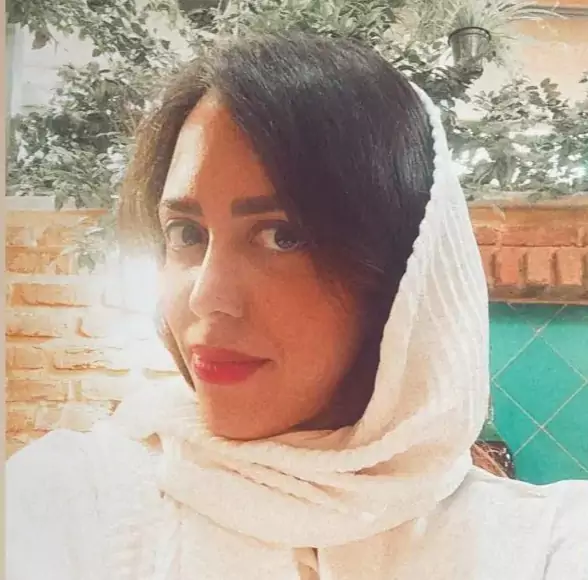
Comments (0)